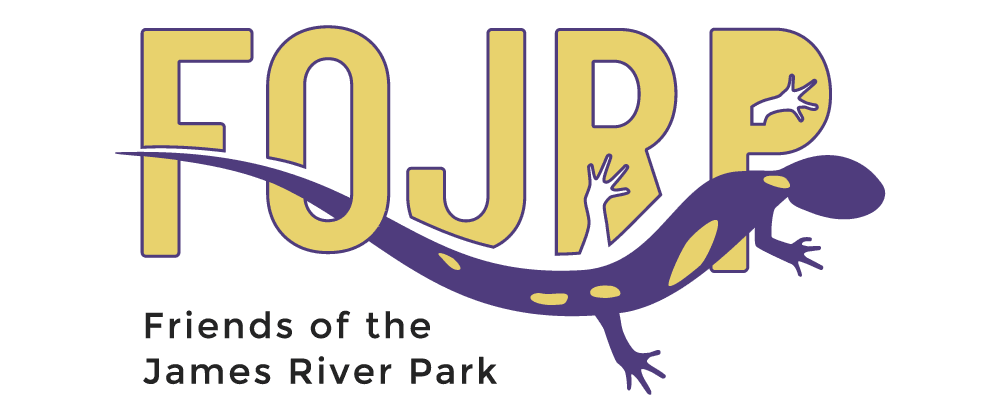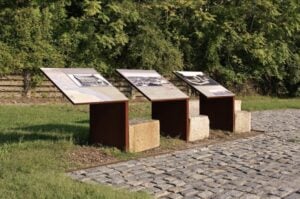Invasive shrub species is a management priority in Pony Pasture
Piles of shrubs and tangled masses of vines. Felled trees awaiting a chipper near freshly chain-sawed stumps.
Invasive plant control is messy, and at first glance, to the uninitiated it often appears destructive. So, what exactly is going on in some of the James River Park System’s invasive management focus areas—what are staff and volunteers doing and why? This winter we will explore some of the projects led by JRPS staff and members of the Invasive Plant Task Force and focus on specific species to better understand why doing good for the park sometimes looks anything but.
If you have visited Pony Pasture recently you probably have noticed towering heaps of branches along trails and near the boat launch and restrooms. Maybe you have also seen volunteers and staff lopping, sawing, and hauling to a trail’s edge these often enormous multi-stemmed shrubs, opening up previously dense thickets. That’s Amur honeysuckle (Lonicera maackii), one of several invasive bush honeysuckle species in Virginia. In Pony Pasture Amur honeysuckle has come to overwhelm the part of a woodland known as the midstory or understory, creating a “monoculture” devoid of indigenous shrub species and degrading habitat in the process. It greens-up early; by late February Amur honeysuckle’s pale green foliage dominates views in the park.
 How can this landscape mainstay whose blossoms deliver that familiar fragrant scent in spring and abundant red berries in fall be bad for wildlife? It starts from the ground up. As with other invasive species, research shows that mature thickets of Amur honeysuckle change soil chemistry, favoring increased spread of invasive species. And that’s just the beginning:
How can this landscape mainstay whose blossoms deliver that familiar fragrant scent in spring and abundant red berries in fall be bad for wildlife? It starts from the ground up. As with other invasive species, research shows that mature thickets of Amur honeysuckle change soil chemistry, favoring increased spread of invasive species. And that’s just the beginning:
- Amur honeysuckle infestations can alter ecosystem hydrology—how water moves through an environment and is used by plants and animals. These water hogs increase “transpiration” (the process by which plants release water into the atmosphere through their leaves and other parts), taking up ground water and drying out soil. That’s more bad luck for native plants trying to survive and for amphibians like the JRPS’s iconic salamanders that rely on vernal pools for reproduction.
- A bird’s nest cradled in honeysuckle branches may suggest that the shrubs are great bird habitat, but it is a little more complicated than that. Honeysuckle’s dense, low, thornless branches encourage nest-building while providing easy access for predators. Research has found higher predation and lower fledgling survival rates compared to nesting in native plant communities.
- But what about those berries birds love to eat? Turns out that Amur honeysuckle berries are a poor substitute for nourishment from the native species they displace. More common winter-resident species like robins do feed on them (thus spreading infestations), but honeysuckle berries lack the fats and proteins needed by migratory species for their long journeys.
 These are just a few ways Amur honeysuckle contributes to the damage invasive plant species do to our Park system and why clearing it from the understory is a management priority. With less Amur honeysuckle, native shrub and tree species stand a better chance. Restoration planting also becomes an option once an area is substantially cleared of invasive cover. And those piles of debris? Most will be either removed or mulched in place.
These are just a few ways Amur honeysuckle contributes to the damage invasive plant species do to our Park system and why clearing it from the understory is a management priority. With less Amur honeysuckle, native shrub and tree species stand a better chance. Restoration planting also becomes an option once an area is substantially cleared of invasive cover. And those piles of debris? Most will be either removed or mulched in place.
Like many invasive species, Amur honeysuckle was deliberately introduced in North America in the late 1880s. It is still a common sight as a cultivated ornamental in the neighborhoods from which it invaded our park system. If you have Amur honeysuckle in your yard, please consider removing it and replacing it with species indigenous to the Richmond region.



